Artificial Intelligence: Revolutionizing Business Analysis Methods
VerifiedAdded on 2023/06/03
|14
|3641
|76
Report
AI Summary
This report discusses the current trends in artificial intelligence and its profound impact on business analysis. It begins by outlining the research methodology used, including a document strategic approach, observational methods, and active participation in AI discussion groups. The report details the increasing use of AI in business for competitive advantages and enhanced processes, focusing on expert systems, evolutionary algorithms, and artificial neural networks. It highlights AI's role in knowledge acquisition, pattern recognition, and the analysis of unstructured data, emphasizing the integration of AI with CRM for better customer insights. The report also touches on the challenges and benefits of AI implementation in areas like marketing, business intelligence, and customer service, concluding that AI is essential for improving business operations, predicting market behavior, and driving revenue growth. Desklib offers further resources and solved assignments for students.
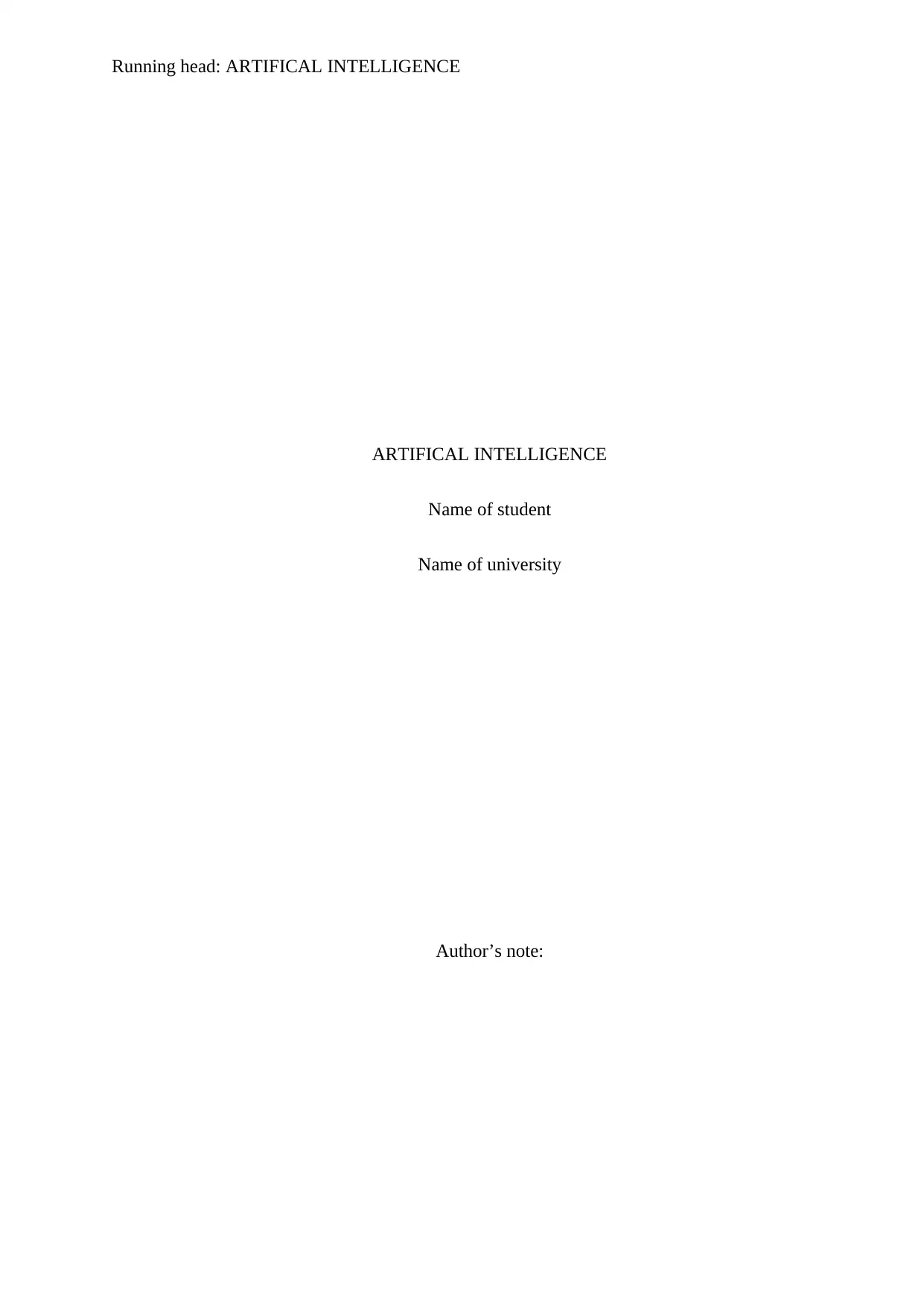
Running head: ARTIFICAL INTELLIGENCE
ARTIFICAL INTELLIGENCE
Name of student
Name of university
Author’s note:
ARTIFICAL INTELLIGENCE
Name of student
Name of university
Author’s note:
Paraphrase This Document
Need a fresh take? Get an instant paraphrase of this document with our AI Paraphraser
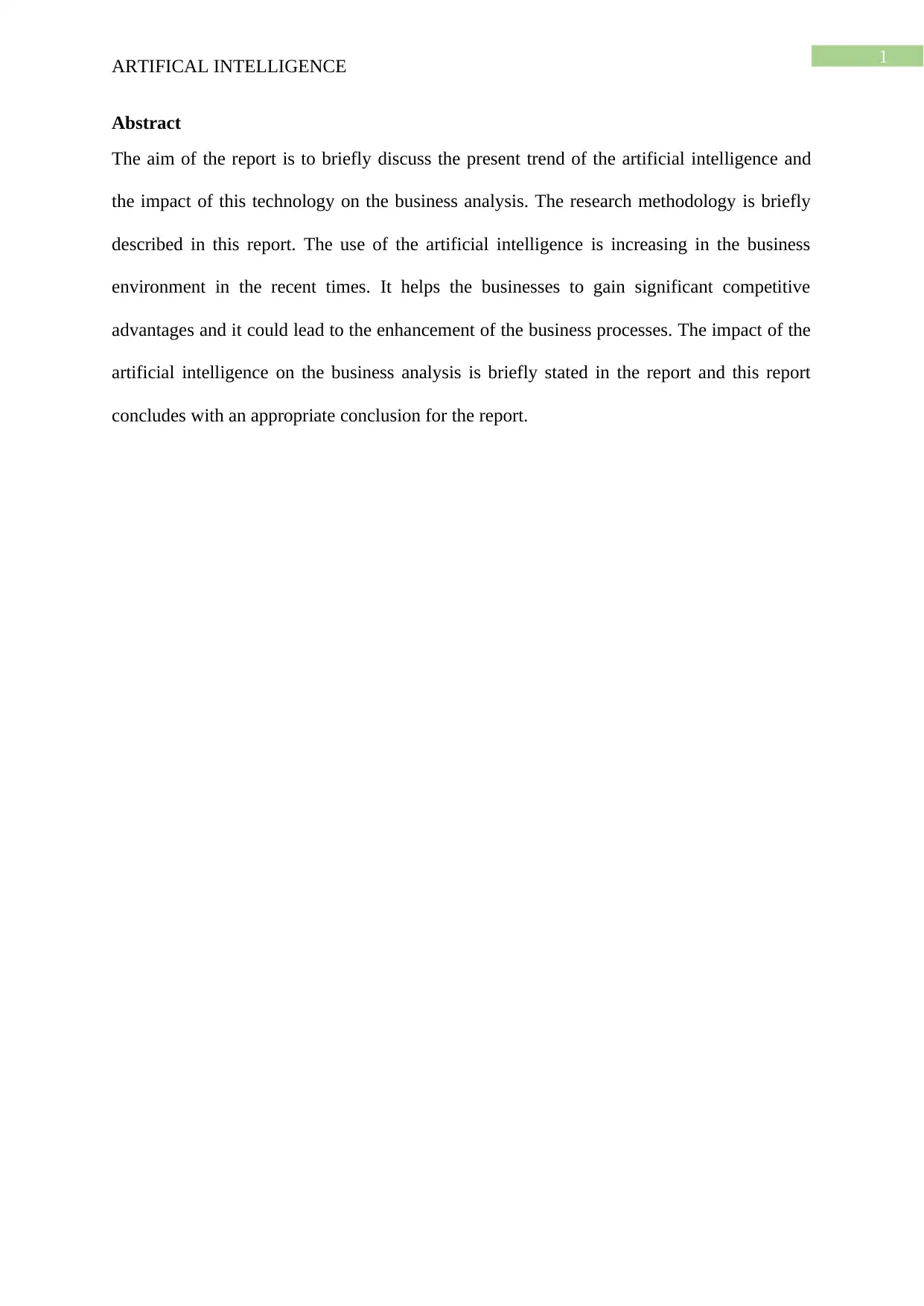
1
ARTIFICAL INTELLIGENCE
Abstract
The aim of the report is to briefly discuss the present trend of the artificial intelligence and
the impact of this technology on the business analysis. The research methodology is briefly
described in this report. The use of the artificial intelligence is increasing in the business
environment in the recent times. It helps the businesses to gain significant competitive
advantages and it could lead to the enhancement of the business processes. The impact of the
artificial intelligence on the business analysis is briefly stated in the report and this report
concludes with an appropriate conclusion for the report.
ARTIFICAL INTELLIGENCE
Abstract
The aim of the report is to briefly discuss the present trend of the artificial intelligence and
the impact of this technology on the business analysis. The research methodology is briefly
described in this report. The use of the artificial intelligence is increasing in the business
environment in the recent times. It helps the businesses to gain significant competitive
advantages and it could lead to the enhancement of the business processes. The impact of the
artificial intelligence on the business analysis is briefly stated in the report and this report
concludes with an appropriate conclusion for the report.
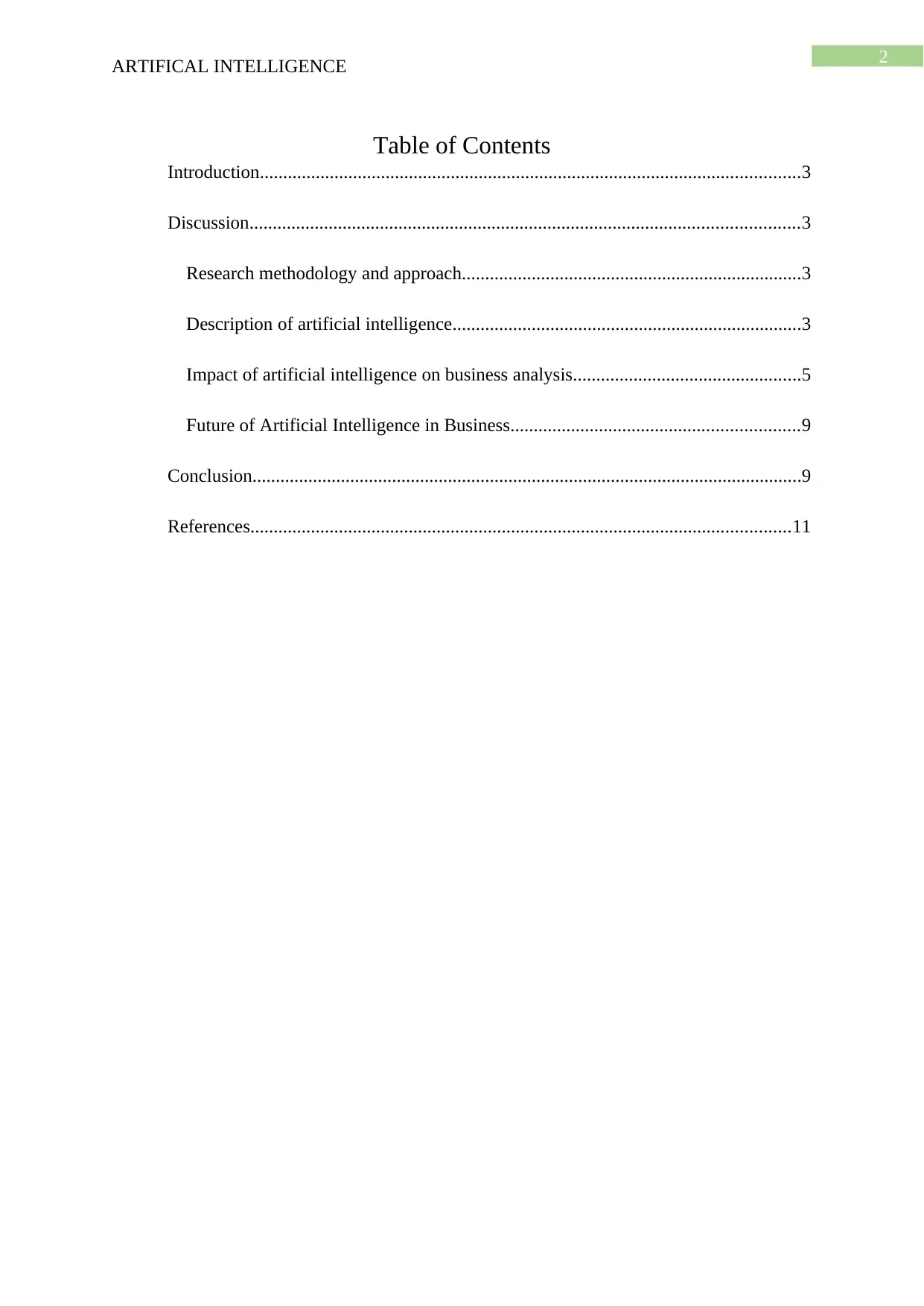
2
ARTIFICAL INTELLIGENCE
Table of Contents
Introduction....................................................................................................................3
Discussion......................................................................................................................3
Research methodology and approach.........................................................................3
Description of artificial intelligence...........................................................................3
Impact of artificial intelligence on business analysis.................................................5
Future of Artificial Intelligence in Business..............................................................9
Conclusion......................................................................................................................9
References....................................................................................................................11
ARTIFICAL INTELLIGENCE
Table of Contents
Introduction....................................................................................................................3
Discussion......................................................................................................................3
Research methodology and approach.........................................................................3
Description of artificial intelligence...........................................................................3
Impact of artificial intelligence on business analysis.................................................5
Future of Artificial Intelligence in Business..............................................................9
Conclusion......................................................................................................................9
References....................................................................................................................11
⊘ This is a preview!⊘
Do you want full access?
Subscribe today to unlock all pages.

Trusted by 1+ million students worldwide
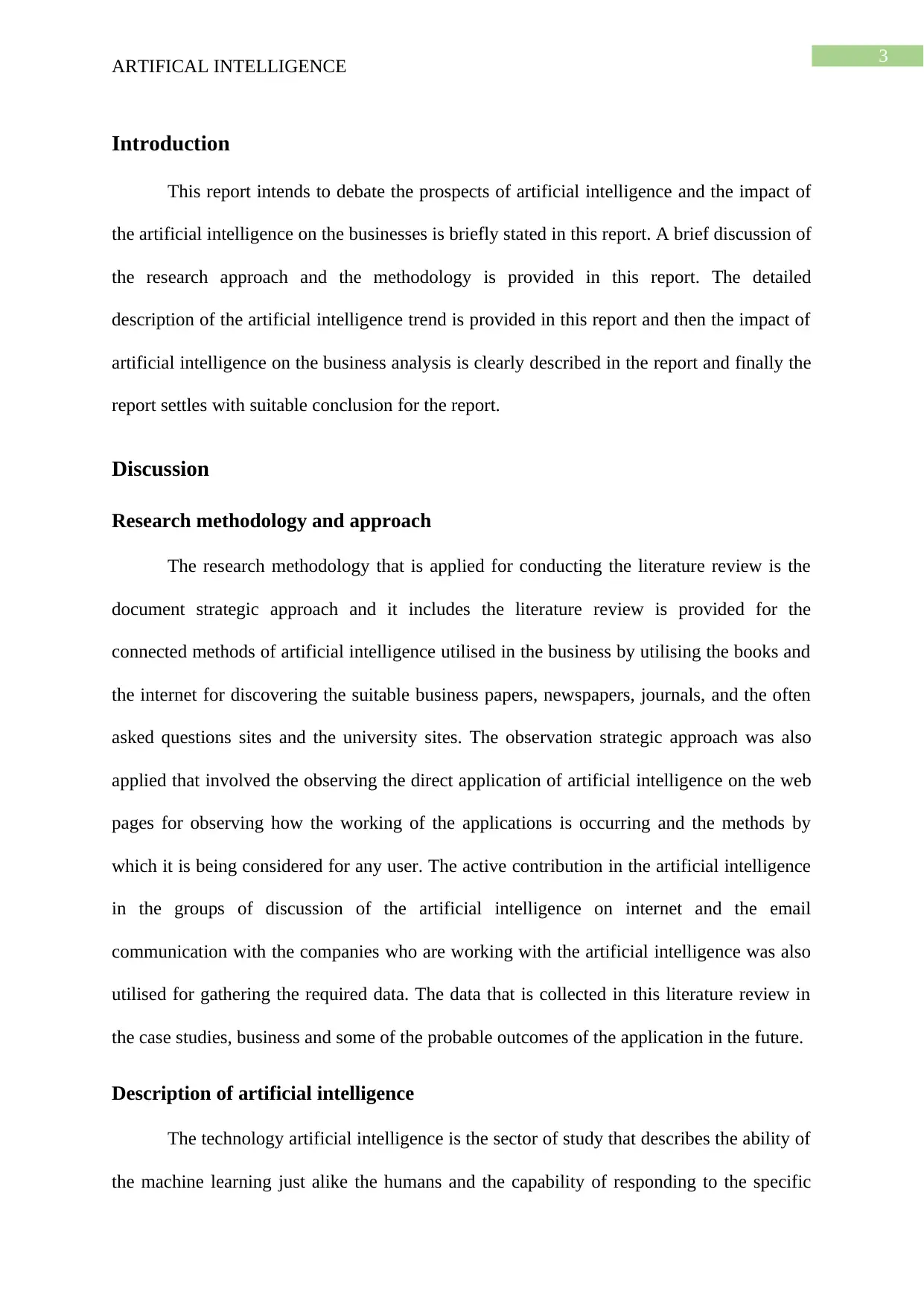
3
ARTIFICAL INTELLIGENCE
Introduction
This report intends to debate the prospects of artificial intelligence and the impact of
the artificial intelligence on the businesses is briefly stated in this report. A brief discussion of
the research approach and the methodology is provided in this report. The detailed
description of the artificial intelligence trend is provided in this report and then the impact of
artificial intelligence on the business analysis is clearly described in the report and finally the
report settles with suitable conclusion for the report.
Discussion
Research methodology and approach
The research methodology that is applied for conducting the literature review is the
document strategic approach and it includes the literature review is provided for the
connected methods of artificial intelligence utilised in the business by utilising the books and
the internet for discovering the suitable business papers, newspapers, journals, and the often
asked questions sites and the university sites. The observation strategic approach was also
applied that involved the observing the direct application of artificial intelligence on the web
pages for observing how the working of the applications is occurring and the methods by
which it is being considered for any user. The active contribution in the artificial intelligence
in the groups of discussion of the artificial intelligence on internet and the email
communication with the companies who are working with the artificial intelligence was also
utilised for gathering the required data. The data that is collected in this literature review in
the case studies, business and some of the probable outcomes of the application in the future.
Description of artificial intelligence
The technology artificial intelligence is the sector of study that describes the ability of
the machine learning just alike the humans and the capability of responding to the specific
ARTIFICAL INTELLIGENCE
Introduction
This report intends to debate the prospects of artificial intelligence and the impact of
the artificial intelligence on the businesses is briefly stated in this report. A brief discussion of
the research approach and the methodology is provided in this report. The detailed
description of the artificial intelligence trend is provided in this report and then the impact of
artificial intelligence on the business analysis is clearly described in the report and finally the
report settles with suitable conclusion for the report.
Discussion
Research methodology and approach
The research methodology that is applied for conducting the literature review is the
document strategic approach and it includes the literature review is provided for the
connected methods of artificial intelligence utilised in the business by utilising the books and
the internet for discovering the suitable business papers, newspapers, journals, and the often
asked questions sites and the university sites. The observation strategic approach was also
applied that involved the observing the direct application of artificial intelligence on the web
pages for observing how the working of the applications is occurring and the methods by
which it is being considered for any user. The active contribution in the artificial intelligence
in the groups of discussion of the artificial intelligence on internet and the email
communication with the companies who are working with the artificial intelligence was also
utilised for gathering the required data. The data that is collected in this literature review in
the case studies, business and some of the probable outcomes of the application in the future.
Description of artificial intelligence
The technology artificial intelligence is the sector of study that describes the ability of
the machine learning just alike the humans and the capability of responding to the specific
Paraphrase This Document
Need a fresh take? Get an instant paraphrase of this document with our AI Paraphraser
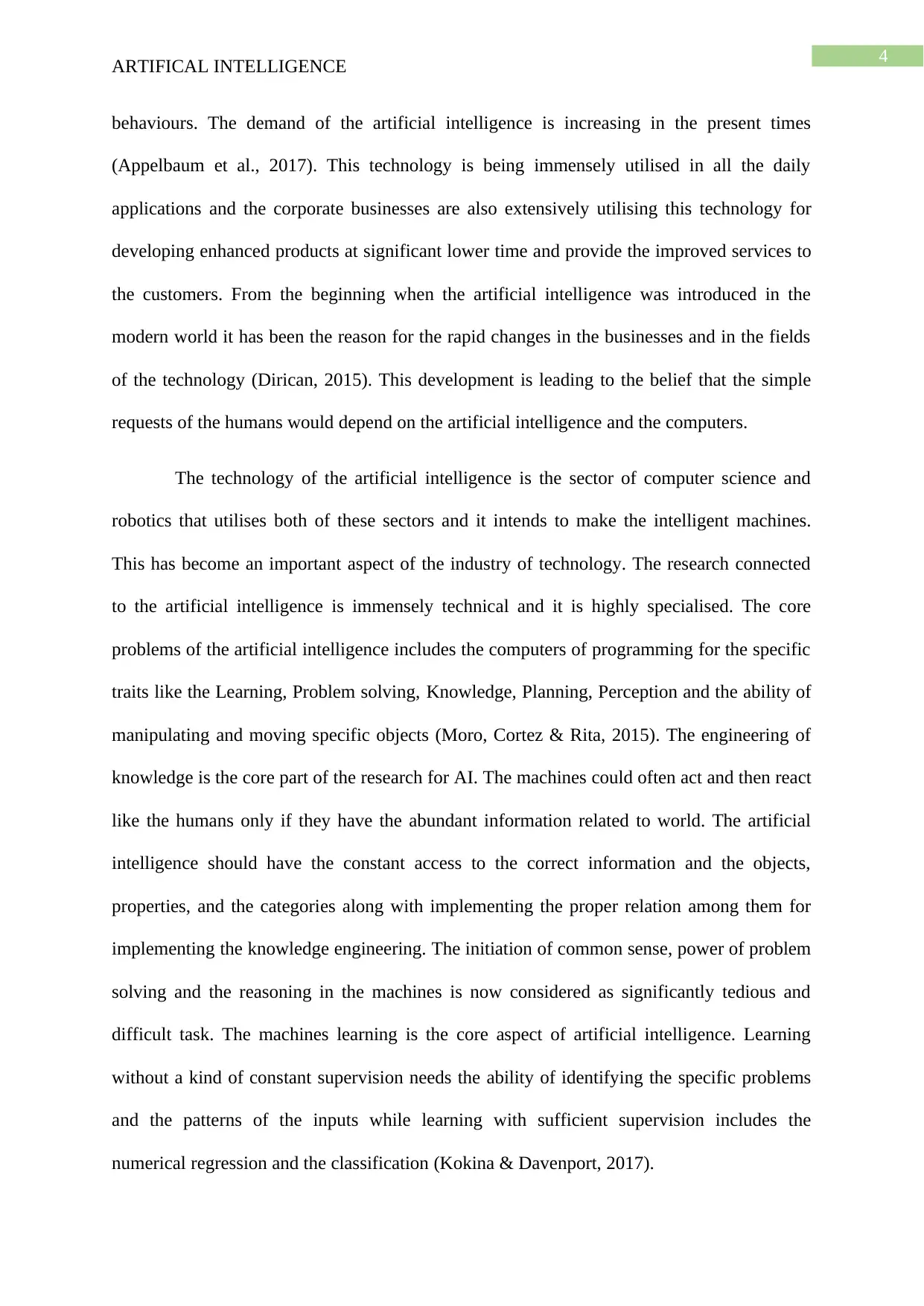
4
ARTIFICAL INTELLIGENCE
behaviours. The demand of the artificial intelligence is increasing in the present times
(Appelbaum et al., 2017). This technology is being immensely utilised in all the daily
applications and the corporate businesses are also extensively utilising this technology for
developing enhanced products at significant lower time and provide the improved services to
the customers. From the beginning when the artificial intelligence was introduced in the
modern world it has been the reason for the rapid changes in the businesses and in the fields
of the technology (Dirican, 2015). This development is leading to the belief that the simple
requests of the humans would depend on the artificial intelligence and the computers.
The technology of the artificial intelligence is the sector of computer science and
robotics that utilises both of these sectors and it intends to make the intelligent machines.
This has become an important aspect of the industry of technology. The research connected
to the artificial intelligence is immensely technical and it is highly specialised. The core
problems of the artificial intelligence includes the computers of programming for the specific
traits like the Learning, Problem solving, Knowledge, Planning, Perception and the ability of
manipulating and moving specific objects (Moro, Cortez & Rita, 2015). The engineering of
knowledge is the core part of the research for AI. The machines could often act and then react
like the humans only if they have the abundant information related to world. The artificial
intelligence should have the constant access to the correct information and the objects,
properties, and the categories along with implementing the proper relation among them for
implementing the knowledge engineering. The initiation of common sense, power of problem
solving and the reasoning in the machines is now considered as significantly tedious and
difficult task. The machines learning is the core aspect of artificial intelligence. Learning
without a kind of constant supervision needs the ability of identifying the specific problems
and the patterns of the inputs while learning with sufficient supervision includes the
numerical regression and the classification (Kokina & Davenport, 2017).
ARTIFICAL INTELLIGENCE
behaviours. The demand of the artificial intelligence is increasing in the present times
(Appelbaum et al., 2017). This technology is being immensely utilised in all the daily
applications and the corporate businesses are also extensively utilising this technology for
developing enhanced products at significant lower time and provide the improved services to
the customers. From the beginning when the artificial intelligence was introduced in the
modern world it has been the reason for the rapid changes in the businesses and in the fields
of the technology (Dirican, 2015). This development is leading to the belief that the simple
requests of the humans would depend on the artificial intelligence and the computers.
The technology of the artificial intelligence is the sector of computer science and
robotics that utilises both of these sectors and it intends to make the intelligent machines.
This has become an important aspect of the industry of technology. The research connected
to the artificial intelligence is immensely technical and it is highly specialised. The core
problems of the artificial intelligence includes the computers of programming for the specific
traits like the Learning, Problem solving, Knowledge, Planning, Perception and the ability of
manipulating and moving specific objects (Moro, Cortez & Rita, 2015). The engineering of
knowledge is the core part of the research for AI. The machines could often act and then react
like the humans only if they have the abundant information related to world. The artificial
intelligence should have the constant access to the correct information and the objects,
properties, and the categories along with implementing the proper relation among them for
implementing the knowledge engineering. The initiation of common sense, power of problem
solving and the reasoning in the machines is now considered as significantly tedious and
difficult task. The machines learning is the core aspect of artificial intelligence. Learning
without a kind of constant supervision needs the ability of identifying the specific problems
and the patterns of the inputs while learning with sufficient supervision includes the
numerical regression and the classification (Kokina & Davenport, 2017).
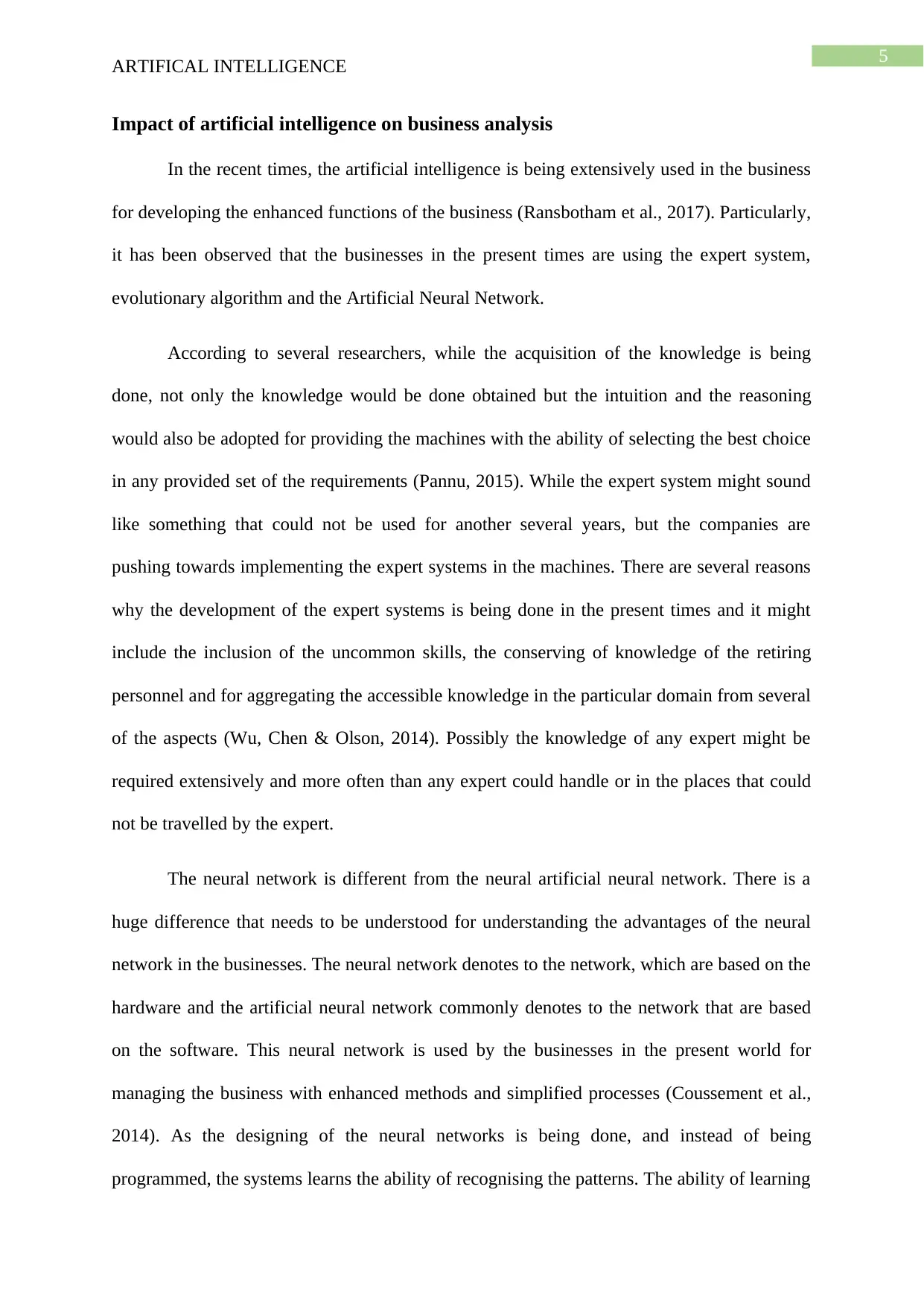
5
ARTIFICAL INTELLIGENCE
Impact of artificial intelligence on business analysis
In the recent times, the artificial intelligence is being extensively used in the business
for developing the enhanced functions of the business (Ransbotham et al., 2017). Particularly,
it has been observed that the businesses in the present times are using the expert system,
evolutionary algorithm and the Artificial Neural Network.
According to several researchers, while the acquisition of the knowledge is being
done, not only the knowledge would be done obtained but the intuition and the reasoning
would also be adopted for providing the machines with the ability of selecting the best choice
in any provided set of the requirements (Pannu, 2015). While the expert system might sound
like something that could not be used for another several years, but the companies are
pushing towards implementing the expert systems in the machines. There are several reasons
why the development of the expert systems is being done in the present times and it might
include the inclusion of the uncommon skills, the conserving of knowledge of the retiring
personnel and for aggregating the accessible knowledge in the particular domain from several
of the aspects (Wu, Chen & Olson, 2014). Possibly the knowledge of any expert might be
required extensively and more often than any expert could handle or in the places that could
not be travelled by the expert.
The neural network is different from the neural artificial neural network. There is a
huge difference that needs to be understood for understanding the advantages of the neural
network in the businesses. The neural network denotes to the network, which are based on the
hardware and the artificial neural network commonly denotes to the network that are based
on the software. This neural network is used by the businesses in the present world for
managing the business with enhanced methods and simplified processes (Coussement et al.,
2014). As the designing of the neural networks is being done, and instead of being
programmed, the systems learns the ability of recognising the patterns. The ability of learning
ARTIFICAL INTELLIGENCE
Impact of artificial intelligence on business analysis
In the recent times, the artificial intelligence is being extensively used in the business
for developing the enhanced functions of the business (Ransbotham et al., 2017). Particularly,
it has been observed that the businesses in the present times are using the expert system,
evolutionary algorithm and the Artificial Neural Network.
According to several researchers, while the acquisition of the knowledge is being
done, not only the knowledge would be done obtained but the intuition and the reasoning
would also be adopted for providing the machines with the ability of selecting the best choice
in any provided set of the requirements (Pannu, 2015). While the expert system might sound
like something that could not be used for another several years, but the companies are
pushing towards implementing the expert systems in the machines. There are several reasons
why the development of the expert systems is being done in the present times and it might
include the inclusion of the uncommon skills, the conserving of knowledge of the retiring
personnel and for aggregating the accessible knowledge in the particular domain from several
of the aspects (Wu, Chen & Olson, 2014). Possibly the knowledge of any expert might be
required extensively and more often than any expert could handle or in the places that could
not be travelled by the expert.
The neural network is different from the neural artificial neural network. There is a
huge difference that needs to be understood for understanding the advantages of the neural
network in the businesses. The neural network denotes to the network, which are based on the
hardware and the artificial neural network commonly denotes to the network that are based
on the software. This neural network is used by the businesses in the present world for
managing the business with enhanced methods and simplified processes (Coussement et al.,
2014). As the designing of the neural networks is being done, and instead of being
programmed, the systems learns the ability of recognising the patterns. The ability of learning
⊘ This is a preview!⊘
Do you want full access?
Subscribe today to unlock all pages.

Trusted by 1+ million students worldwide
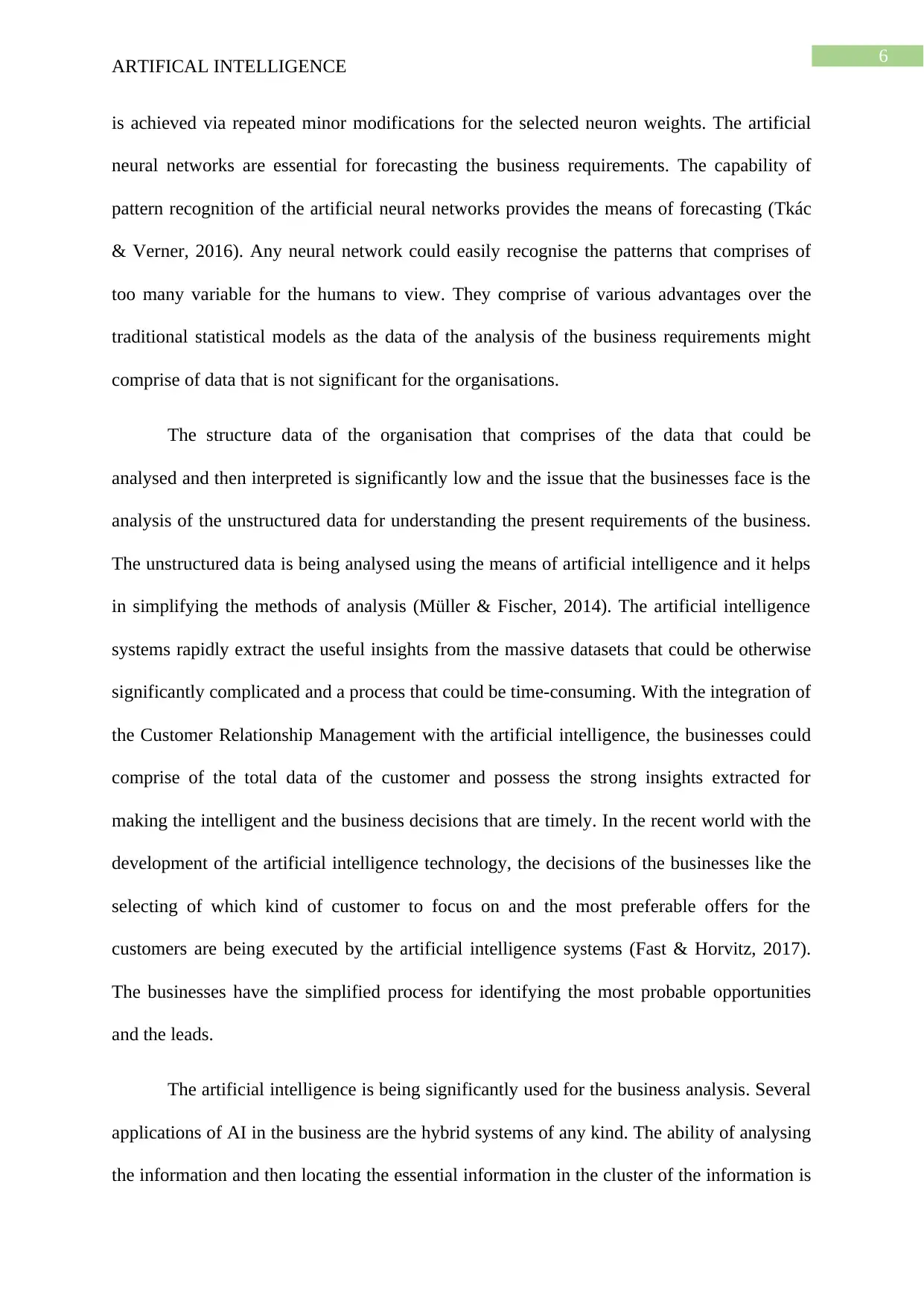
6
ARTIFICAL INTELLIGENCE
is achieved via repeated minor modifications for the selected neuron weights. The artificial
neural networks are essential for forecasting the business requirements. The capability of
pattern recognition of the artificial neural networks provides the means of forecasting (Tkác
& Verner, 2016). Any neural network could easily recognise the patterns that comprises of
too many variable for the humans to view. They comprise of various advantages over the
traditional statistical models as the data of the analysis of the business requirements might
comprise of data that is not significant for the organisations.
The structure data of the organisation that comprises of the data that could be
analysed and then interpreted is significantly low and the issue that the businesses face is the
analysis of the unstructured data for understanding the present requirements of the business.
The unstructured data is being analysed using the means of artificial intelligence and it helps
in simplifying the methods of analysis (Müller & Fischer, 2014). The artificial intelligence
systems rapidly extract the useful insights from the massive datasets that could be otherwise
significantly complicated and a process that could be time-consuming. With the integration of
the Customer Relationship Management with the artificial intelligence, the businesses could
comprise of the total data of the customer and possess the strong insights extracted for
making the intelligent and the business decisions that are timely. In the recent world with the
development of the artificial intelligence technology, the decisions of the businesses like the
selecting of which kind of customer to focus on and the most preferable offers for the
customers are being executed by the artificial intelligence systems (Fast & Horvitz, 2017).
The businesses have the simplified process for identifying the most probable opportunities
and the leads.
The artificial intelligence is being significantly used for the business analysis. Several
applications of AI in the business are the hybrid systems of any kind. The ability of analysing
the information and then locating the essential information in the cluster of the information is
ARTIFICAL INTELLIGENCE
is achieved via repeated minor modifications for the selected neuron weights. The artificial
neural networks are essential for forecasting the business requirements. The capability of
pattern recognition of the artificial neural networks provides the means of forecasting (Tkác
& Verner, 2016). Any neural network could easily recognise the patterns that comprises of
too many variable for the humans to view. They comprise of various advantages over the
traditional statistical models as the data of the analysis of the business requirements might
comprise of data that is not significant for the organisations.
The structure data of the organisation that comprises of the data that could be
analysed and then interpreted is significantly low and the issue that the businesses face is the
analysis of the unstructured data for understanding the present requirements of the business.
The unstructured data is being analysed using the means of artificial intelligence and it helps
in simplifying the methods of analysis (Müller & Fischer, 2014). The artificial intelligence
systems rapidly extract the useful insights from the massive datasets that could be otherwise
significantly complicated and a process that could be time-consuming. With the integration of
the Customer Relationship Management with the artificial intelligence, the businesses could
comprise of the total data of the customer and possess the strong insights extracted for
making the intelligent and the business decisions that are timely. In the recent world with the
development of the artificial intelligence technology, the decisions of the businesses like the
selecting of which kind of customer to focus on and the most preferable offers for the
customers are being executed by the artificial intelligence systems (Fast & Horvitz, 2017).
The businesses have the simplified process for identifying the most probable opportunities
and the leads.
The artificial intelligence is being significantly used for the business analysis. Several
applications of AI in the business are the hybrid systems of any kind. The ability of analysing
the information and then locating the essential information in the cluster of the information is
Paraphrase This Document
Need a fresh take? Get an instant paraphrase of this document with our AI Paraphraser
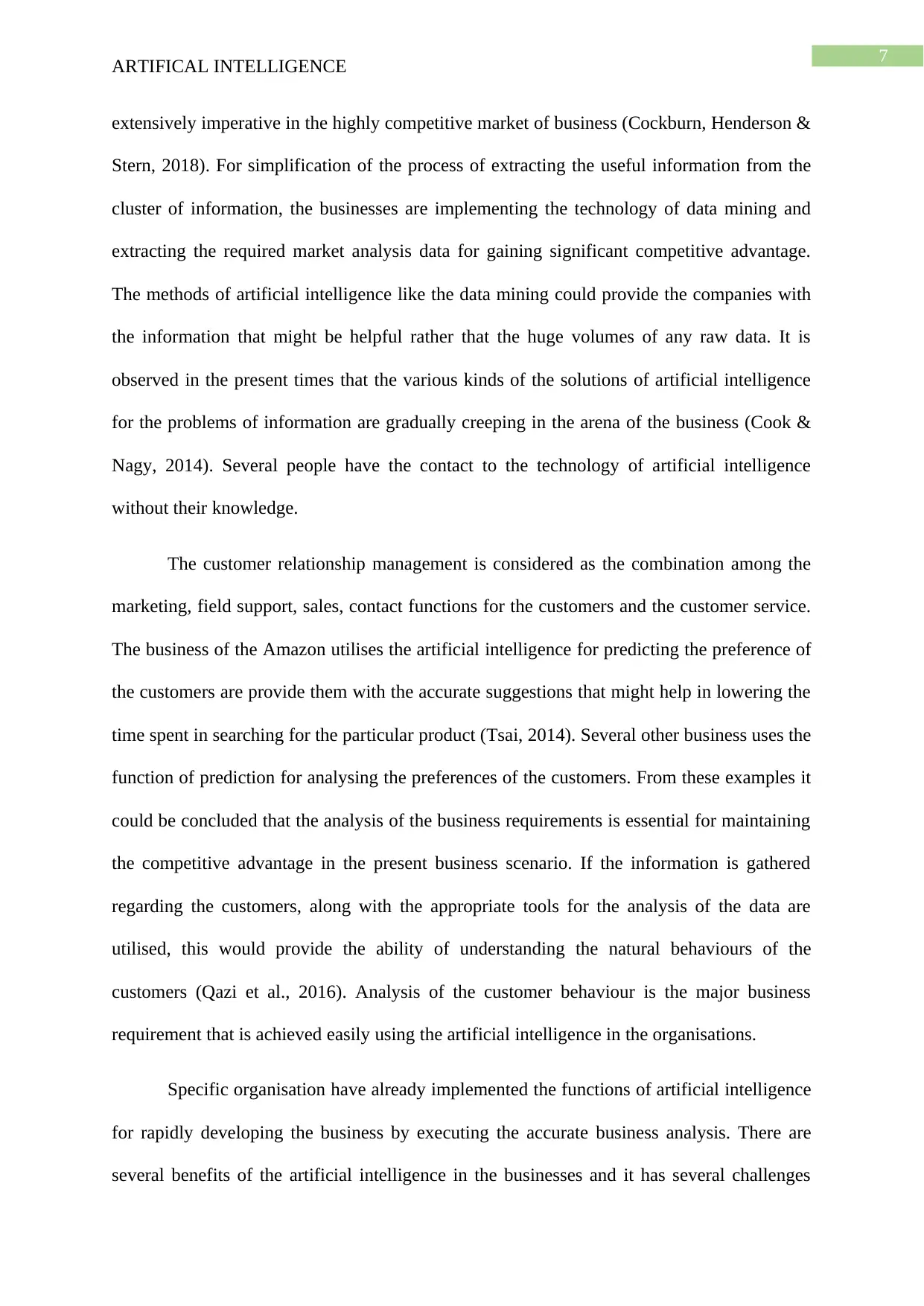
7
ARTIFICAL INTELLIGENCE
extensively imperative in the highly competitive market of business (Cockburn, Henderson &
Stern, 2018). For simplification of the process of extracting the useful information from the
cluster of information, the businesses are implementing the technology of data mining and
extracting the required market analysis data for gaining significant competitive advantage.
The methods of artificial intelligence like the data mining could provide the companies with
the information that might be helpful rather that the huge volumes of any raw data. It is
observed in the present times that the various kinds of the solutions of artificial intelligence
for the problems of information are gradually creeping in the arena of the business (Cook &
Nagy, 2014). Several people have the contact to the technology of artificial intelligence
without their knowledge.
The customer relationship management is considered as the combination among the
marketing, field support, sales, contact functions for the customers and the customer service.
The business of the Amazon utilises the artificial intelligence for predicting the preference of
the customers are provide them with the accurate suggestions that might help in lowering the
time spent in searching for the particular product (Tsai, 2014). Several other business uses the
function of prediction for analysing the preferences of the customers. From these examples it
could be concluded that the analysis of the business requirements is essential for maintaining
the competitive advantage in the present business scenario. If the information is gathered
regarding the customers, along with the appropriate tools for the analysis of the data are
utilised, this would provide the ability of understanding the natural behaviours of the
customers (Qazi et al., 2016). Analysis of the customer behaviour is the major business
requirement that is achieved easily using the artificial intelligence in the organisations.
Specific organisation have already implemented the functions of artificial intelligence
for rapidly developing the business by executing the accurate business analysis. There are
several benefits of the artificial intelligence in the businesses and it has several challenges
ARTIFICAL INTELLIGENCE
extensively imperative in the highly competitive market of business (Cockburn, Henderson &
Stern, 2018). For simplification of the process of extracting the useful information from the
cluster of information, the businesses are implementing the technology of data mining and
extracting the required market analysis data for gaining significant competitive advantage.
The methods of artificial intelligence like the data mining could provide the companies with
the information that might be helpful rather that the huge volumes of any raw data. It is
observed in the present times that the various kinds of the solutions of artificial intelligence
for the problems of information are gradually creeping in the arena of the business (Cook &
Nagy, 2014). Several people have the contact to the technology of artificial intelligence
without their knowledge.
The customer relationship management is considered as the combination among the
marketing, field support, sales, contact functions for the customers and the customer service.
The business of the Amazon utilises the artificial intelligence for predicting the preference of
the customers are provide them with the accurate suggestions that might help in lowering the
time spent in searching for the particular product (Tsai, 2014). Several other business uses the
function of prediction for analysing the preferences of the customers. From these examples it
could be concluded that the analysis of the business requirements is essential for maintaining
the competitive advantage in the present business scenario. If the information is gathered
regarding the customers, along with the appropriate tools for the analysis of the data are
utilised, this would provide the ability of understanding the natural behaviours of the
customers (Qazi et al., 2016). Analysis of the customer behaviour is the major business
requirement that is achieved easily using the artificial intelligence in the organisations.
Specific organisation have already implemented the functions of artificial intelligence
for rapidly developing the business by executing the accurate business analysis. There are
several benefits of the artificial intelligence in the businesses and it has several challenges
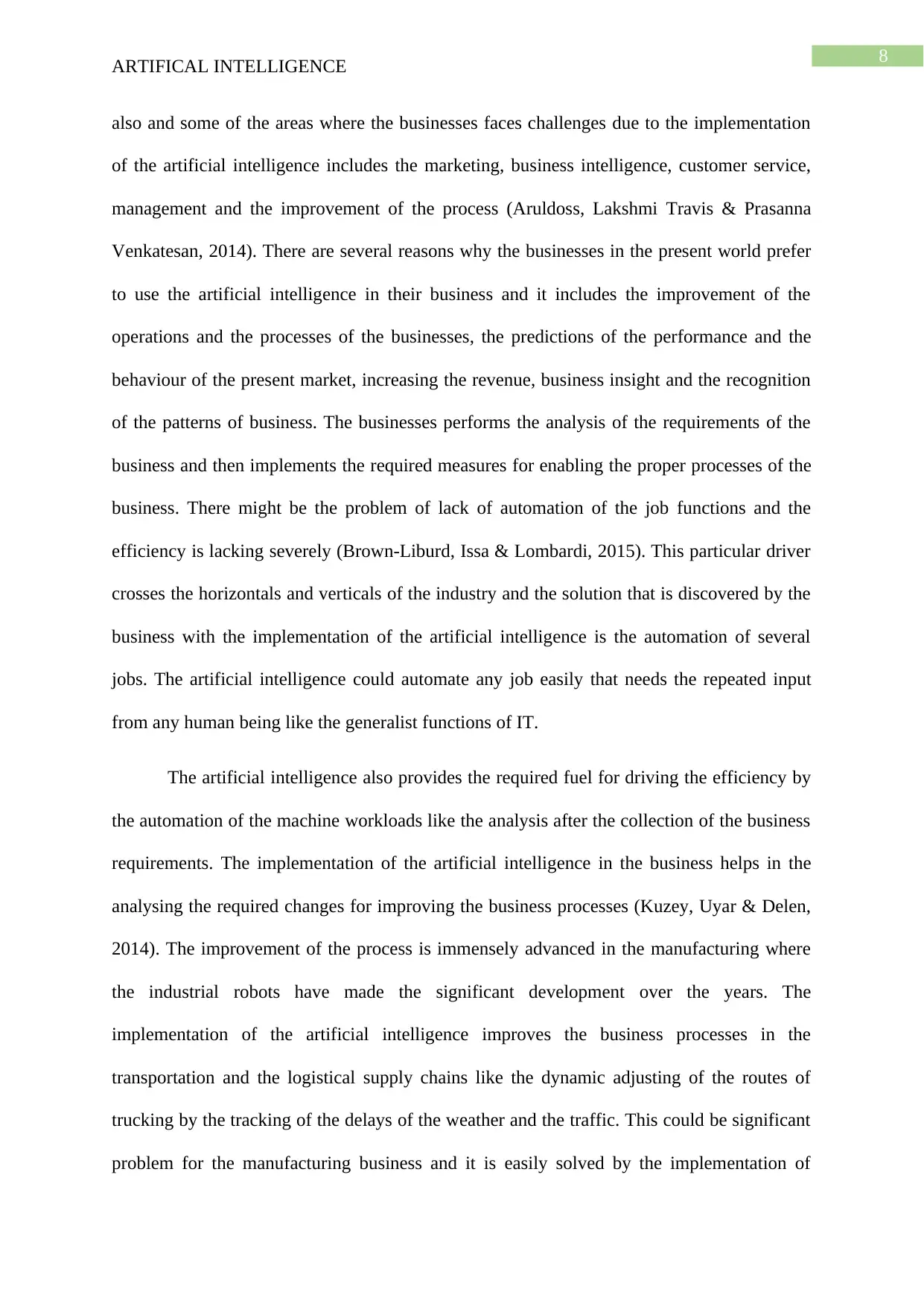
8
ARTIFICAL INTELLIGENCE
also and some of the areas where the businesses faces challenges due to the implementation
of the artificial intelligence includes the marketing, business intelligence, customer service,
management and the improvement of the process (Aruldoss, Lakshmi Travis & Prasanna
Venkatesan, 2014). There are several reasons why the businesses in the present world prefer
to use the artificial intelligence in their business and it includes the improvement of the
operations and the processes of the businesses, the predictions of the performance and the
behaviour of the present market, increasing the revenue, business insight and the recognition
of the patterns of business. The businesses performs the analysis of the requirements of the
business and then implements the required measures for enabling the proper processes of the
business. There might be the problem of lack of automation of the job functions and the
efficiency is lacking severely (Brown-Liburd, Issa & Lombardi, 2015). This particular driver
crosses the horizontals and verticals of the industry and the solution that is discovered by the
business with the implementation of the artificial intelligence is the automation of several
jobs. The artificial intelligence could automate any job easily that needs the repeated input
from any human being like the generalist functions of IT.
The artificial intelligence also provides the required fuel for driving the efficiency by
the automation of the machine workloads like the analysis after the collection of the business
requirements. The implementation of the artificial intelligence in the business helps in the
analysing the required changes for improving the business processes (Kuzey, Uyar & Delen,
2014). The improvement of the process is immensely advanced in the manufacturing where
the industrial robots have made the significant development over the years. The
implementation of the artificial intelligence improves the business processes in the
transportation and the logistical supply chains like the dynamic adjusting of the routes of
trucking by the tracking of the delays of the weather and the traffic. This could be significant
problem for the manufacturing business and it is easily solved by the implementation of
ARTIFICAL INTELLIGENCE
also and some of the areas where the businesses faces challenges due to the implementation
of the artificial intelligence includes the marketing, business intelligence, customer service,
management and the improvement of the process (Aruldoss, Lakshmi Travis & Prasanna
Venkatesan, 2014). There are several reasons why the businesses in the present world prefer
to use the artificial intelligence in their business and it includes the improvement of the
operations and the processes of the businesses, the predictions of the performance and the
behaviour of the present market, increasing the revenue, business insight and the recognition
of the patterns of business. The businesses performs the analysis of the requirements of the
business and then implements the required measures for enabling the proper processes of the
business. There might be the problem of lack of automation of the job functions and the
efficiency is lacking severely (Brown-Liburd, Issa & Lombardi, 2015). This particular driver
crosses the horizontals and verticals of the industry and the solution that is discovered by the
business with the implementation of the artificial intelligence is the automation of several
jobs. The artificial intelligence could automate any job easily that needs the repeated input
from any human being like the generalist functions of IT.
The artificial intelligence also provides the required fuel for driving the efficiency by
the automation of the machine workloads like the analysis after the collection of the business
requirements. The implementation of the artificial intelligence in the business helps in the
analysing the required changes for improving the business processes (Kuzey, Uyar & Delen,
2014). The improvement of the process is immensely advanced in the manufacturing where
the industrial robots have made the significant development over the years. The
implementation of the artificial intelligence improves the business processes in the
transportation and the logistical supply chains like the dynamic adjusting of the routes of
trucking by the tracking of the delays of the weather and the traffic. This could be significant
problem for the manufacturing business and it is easily solved by the implementation of
⊘ This is a preview!⊘
Do you want full access?
Subscribe today to unlock all pages.

Trusted by 1+ million students worldwide
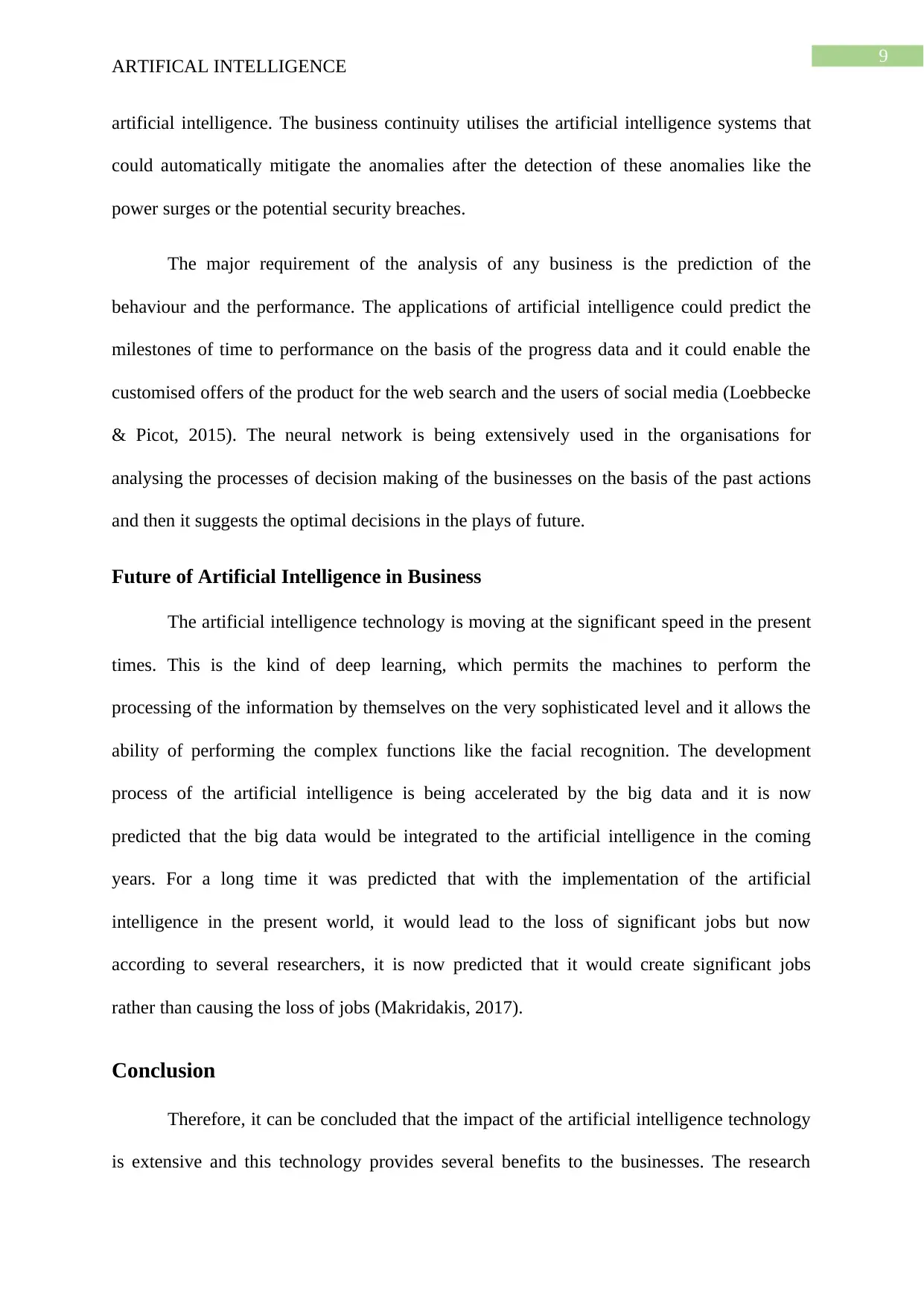
9
ARTIFICAL INTELLIGENCE
artificial intelligence. The business continuity utilises the artificial intelligence systems that
could automatically mitigate the anomalies after the detection of these anomalies like the
power surges or the potential security breaches.
The major requirement of the analysis of any business is the prediction of the
behaviour and the performance. The applications of artificial intelligence could predict the
milestones of time to performance on the basis of the progress data and it could enable the
customised offers of the product for the web search and the users of social media (Loebbecke
& Picot, 2015). The neural network is being extensively used in the organisations for
analysing the processes of decision making of the businesses on the basis of the past actions
and then it suggests the optimal decisions in the plays of future.
Future of Artificial Intelligence in Business
The artificial intelligence technology is moving at the significant speed in the present
times. This is the kind of deep learning, which permits the machines to perform the
processing of the information by themselves on the very sophisticated level and it allows the
ability of performing the complex functions like the facial recognition. The development
process of the artificial intelligence is being accelerated by the big data and it is now
predicted that the big data would be integrated to the artificial intelligence in the coming
years. For a long time it was predicted that with the implementation of the artificial
intelligence in the present world, it would lead to the loss of significant jobs but now
according to several researchers, it is now predicted that it would create significant jobs
rather than causing the loss of jobs (Makridakis, 2017).
Conclusion
Therefore, it can be concluded that the impact of the artificial intelligence technology
is extensive and this technology provides several benefits to the businesses. The research
ARTIFICAL INTELLIGENCE
artificial intelligence. The business continuity utilises the artificial intelligence systems that
could automatically mitigate the anomalies after the detection of these anomalies like the
power surges or the potential security breaches.
The major requirement of the analysis of any business is the prediction of the
behaviour and the performance. The applications of artificial intelligence could predict the
milestones of time to performance on the basis of the progress data and it could enable the
customised offers of the product for the web search and the users of social media (Loebbecke
& Picot, 2015). The neural network is being extensively used in the organisations for
analysing the processes of decision making of the businesses on the basis of the past actions
and then it suggests the optimal decisions in the plays of future.
Future of Artificial Intelligence in Business
The artificial intelligence technology is moving at the significant speed in the present
times. This is the kind of deep learning, which permits the machines to perform the
processing of the information by themselves on the very sophisticated level and it allows the
ability of performing the complex functions like the facial recognition. The development
process of the artificial intelligence is being accelerated by the big data and it is now
predicted that the big data would be integrated to the artificial intelligence in the coming
years. For a long time it was predicted that with the implementation of the artificial
intelligence in the present world, it would lead to the loss of significant jobs but now
according to several researchers, it is now predicted that it would create significant jobs
rather than causing the loss of jobs (Makridakis, 2017).
Conclusion
Therefore, it can be concluded that the impact of the artificial intelligence technology
is extensive and this technology provides several benefits to the businesses. The research
Paraphrase This Document
Need a fresh take? Get an instant paraphrase of this document with our AI Paraphraser
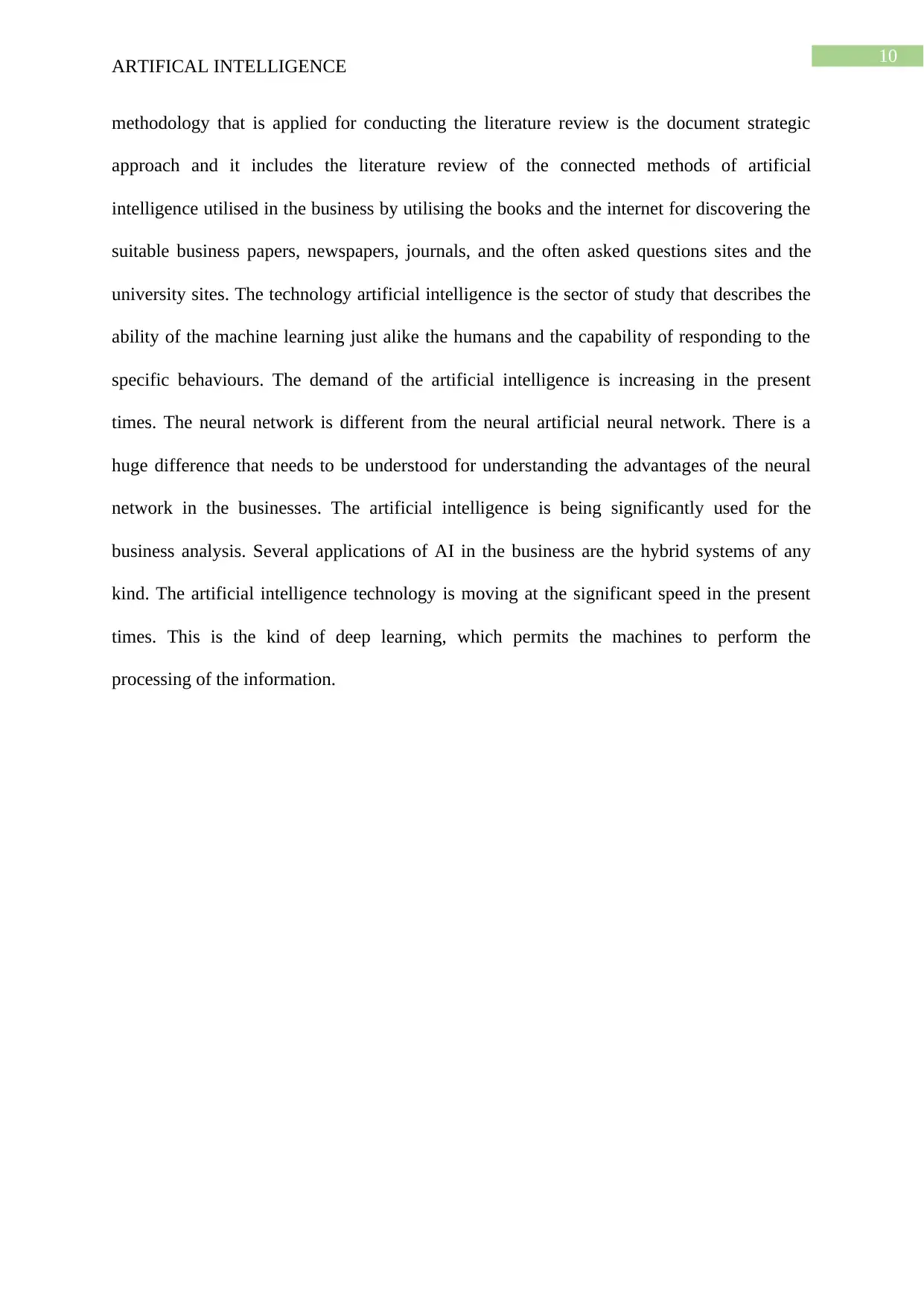
10
ARTIFICAL INTELLIGENCE
methodology that is applied for conducting the literature review is the document strategic
approach and it includes the literature review of the connected methods of artificial
intelligence utilised in the business by utilising the books and the internet for discovering the
suitable business papers, newspapers, journals, and the often asked questions sites and the
university sites. The technology artificial intelligence is the sector of study that describes the
ability of the machine learning just alike the humans and the capability of responding to the
specific behaviours. The demand of the artificial intelligence is increasing in the present
times. The neural network is different from the neural artificial neural network. There is a
huge difference that needs to be understood for understanding the advantages of the neural
network in the businesses. The artificial intelligence is being significantly used for the
business analysis. Several applications of AI in the business are the hybrid systems of any
kind. The artificial intelligence technology is moving at the significant speed in the present
times. This is the kind of deep learning, which permits the machines to perform the
processing of the information.
ARTIFICAL INTELLIGENCE
methodology that is applied for conducting the literature review is the document strategic
approach and it includes the literature review of the connected methods of artificial
intelligence utilised in the business by utilising the books and the internet for discovering the
suitable business papers, newspapers, journals, and the often asked questions sites and the
university sites. The technology artificial intelligence is the sector of study that describes the
ability of the machine learning just alike the humans and the capability of responding to the
specific behaviours. The demand of the artificial intelligence is increasing in the present
times. The neural network is different from the neural artificial neural network. There is a
huge difference that needs to be understood for understanding the advantages of the neural
network in the businesses. The artificial intelligence is being significantly used for the
business analysis. Several applications of AI in the business are the hybrid systems of any
kind. The artificial intelligence technology is moving at the significant speed in the present
times. This is the kind of deep learning, which permits the machines to perform the
processing of the information.
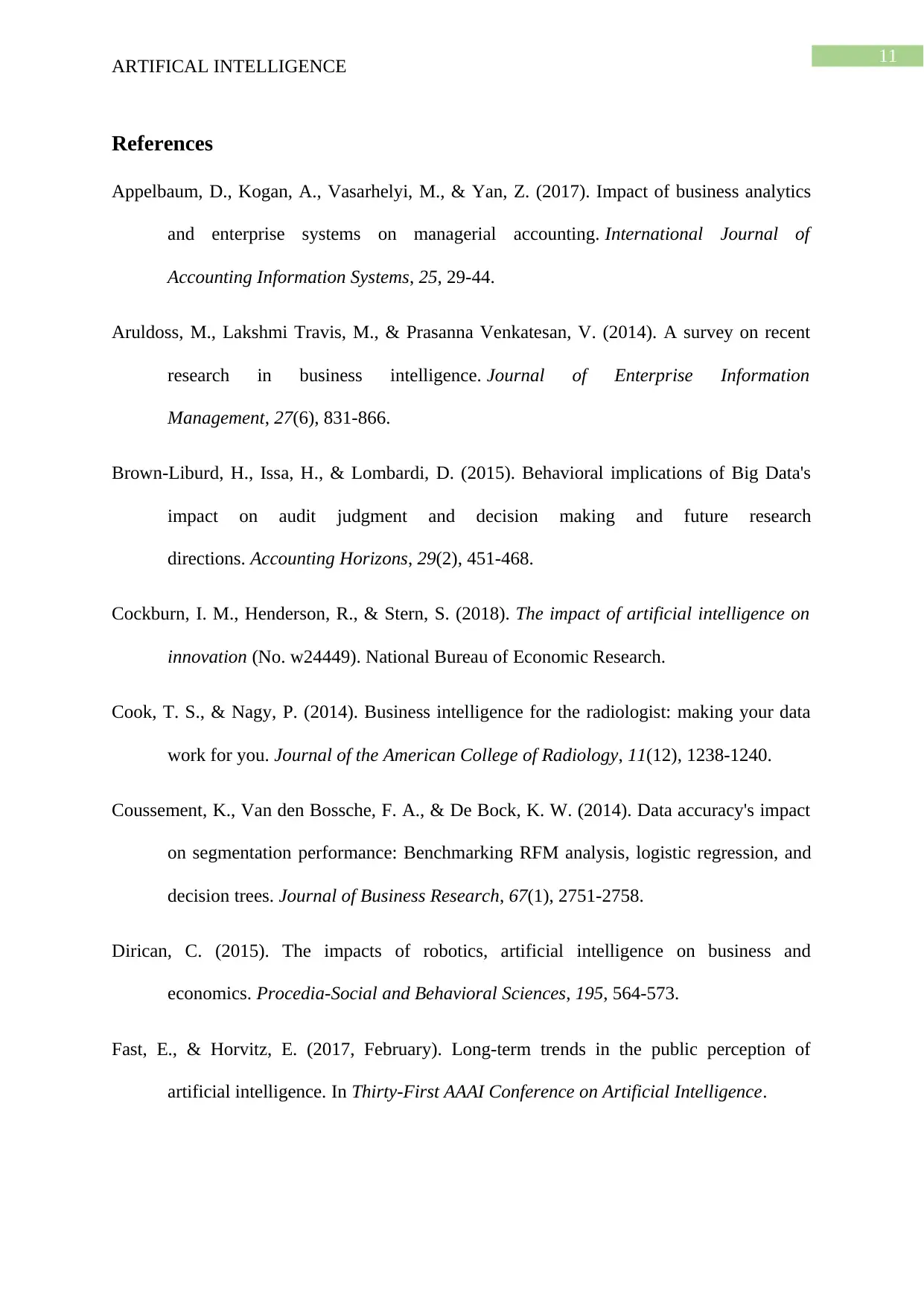
11
ARTIFICAL INTELLIGENCE
References
Appelbaum, D., Kogan, A., Vasarhelyi, M., & Yan, Z. (2017). Impact of business analytics
and enterprise systems on managerial accounting. International Journal of
Accounting Information Systems, 25, 29-44.
Aruldoss, M., Lakshmi Travis, M., & Prasanna Venkatesan, V. (2014). A survey on recent
research in business intelligence. Journal of Enterprise Information
Management, 27(6), 831-866.
Brown-Liburd, H., Issa, H., & Lombardi, D. (2015). Behavioral implications of Big Data's
impact on audit judgment and decision making and future research
directions. Accounting Horizons, 29(2), 451-468.
Cockburn, I. M., Henderson, R., & Stern, S. (2018). The impact of artificial intelligence on
innovation (No. w24449). National Bureau of Economic Research.
Cook, T. S., & Nagy, P. (2014). Business intelligence for the radiologist: making your data
work for you. Journal of the American College of Radiology, 11(12), 1238-1240.
Coussement, K., Van den Bossche, F. A., & De Bock, K. W. (2014). Data accuracy's impact
on segmentation performance: Benchmarking RFM analysis, logistic regression, and
decision trees. Journal of Business Research, 67(1), 2751-2758.
Dirican, C. (2015). The impacts of robotics, artificial intelligence on business and
economics. Procedia-Social and Behavioral Sciences, 195, 564-573.
Fast, E., & Horvitz, E. (2017, February). Long-term trends in the public perception of
artificial intelligence. In Thirty-First AAAI Conference on Artificial Intelligence.
ARTIFICAL INTELLIGENCE
References
Appelbaum, D., Kogan, A., Vasarhelyi, M., & Yan, Z. (2017). Impact of business analytics
and enterprise systems on managerial accounting. International Journal of
Accounting Information Systems, 25, 29-44.
Aruldoss, M., Lakshmi Travis, M., & Prasanna Venkatesan, V. (2014). A survey on recent
research in business intelligence. Journal of Enterprise Information
Management, 27(6), 831-866.
Brown-Liburd, H., Issa, H., & Lombardi, D. (2015). Behavioral implications of Big Data's
impact on audit judgment and decision making and future research
directions. Accounting Horizons, 29(2), 451-468.
Cockburn, I. M., Henderson, R., & Stern, S. (2018). The impact of artificial intelligence on
innovation (No. w24449). National Bureau of Economic Research.
Cook, T. S., & Nagy, P. (2014). Business intelligence for the radiologist: making your data
work for you. Journal of the American College of Radiology, 11(12), 1238-1240.
Coussement, K., Van den Bossche, F. A., & De Bock, K. W. (2014). Data accuracy's impact
on segmentation performance: Benchmarking RFM analysis, logistic regression, and
decision trees. Journal of Business Research, 67(1), 2751-2758.
Dirican, C. (2015). The impacts of robotics, artificial intelligence on business and
economics. Procedia-Social and Behavioral Sciences, 195, 564-573.
Fast, E., & Horvitz, E. (2017, February). Long-term trends in the public perception of
artificial intelligence. In Thirty-First AAAI Conference on Artificial Intelligence.
⊘ This is a preview!⊘
Do you want full access?
Subscribe today to unlock all pages.

Trusted by 1+ million students worldwide
1 out of 14
Related Documents
Your All-in-One AI-Powered Toolkit for Academic Success.
+13062052269
info@desklib.com
Available 24*7 on WhatsApp / Email
![[object Object]](/_next/static/media/star-bottom.7253800d.svg)
Unlock your academic potential
Copyright © 2020–2025 A2Z Services. All Rights Reserved. Developed and managed by ZUCOL.



